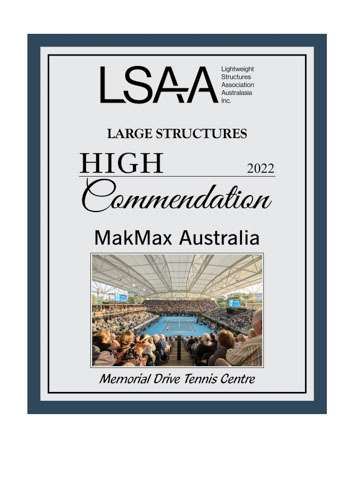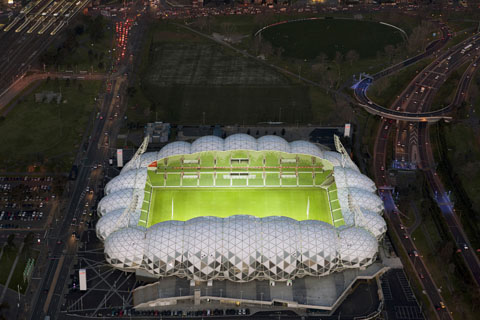Entrant: UFS Australasia Pty Ltd - Designer / Fabricator
Location: 190 King Arthur Terrace - Tennyson Qld 4105
Client: Mirvac Architect: Mirvac Design Struct. Eng.: Wade Engineering
Specialist: Steel Structures Australia
Builder: Universal Fabric Structures / Ozrig
Fabricator: Skyspan Asia
This project was entered in the LSAA 2009 Design Awards, Category 3 (#37008)
Description
The Queensland State Government approved and funded the development of a first class international tennis facility for Queensland to be located in the Brisbane CBD at Tennyson. The facility offers all tennis playing surfaces, a covered main court stadium and two covered outdoor championship size show courts. The State Tennis Centre was completed in time for the Adidas international in January 2009.
Commendation LSAA 2018 Design Awards Large Structures (Cat 4, 4433)
Application: Large canopies with a fabric surface area over 2800m2 to cover multiple areas at the Inglis Selling Centre Warwick Farm Racecourse
Inglis Selling Centre Fabric Roofs at Warwick Farm - Project Description
The project was the design, fabrication and installation of multiple decorative and functional canopies for the Inglis Selling Centre at Warwick Farm Racecourse. With an overall Chukoh FGT800 PTFE fabric area of approximately 3060m2, the project covered multiple areas and structure types - “Trees” to cover the horse parade ring; a shelter canopy for the patron walkway for the pre-parade ring; a canopy for the wedding pavilion, and awnings for the hotel.
LSAA 2011 Design Award Entry: Cat 4 The Cloud, Auckland, New Zealand
APPLICATION OF PROJECT:
The Cloud is a semi permanent multi purpose event & exhibition structure, initially developed for the Rugby World Cup
PROJECT DESCRIPTION
The Cloud is a semi permanent structure erected on the western edge of Queens Wharf to accommodate the city's commitment to hosting an inner-city fanzone, festival and showcase event during the Rugby World Cup 2011. Installed as part of the recent 18 month redevelopment of Queens Wharf, The Cloud will be utilised by NZ2011 to showcase the best of New Zealand innovation and creativity during the REAL New Zealand Showcase. At almost 180m long, The Cloud can accommodate up to 6,000 people.
This project was entered in the 2013 LSAA Design Awards (Large Structures, 4352)
Entrant: Light Weight Structures
- Location: Neath Street Cessnock NSW
- Client: East Cessnock Bowls Club
- Completion Date: September 2012
East Cessnock Bowling Club - New Fabric Roof
The project covered one Bowling Green measuring 1820 sqmts. The project was designed to offer weather protection to bowlers, including night time use of the Bowling Green (in a residential setting) and minimal cleaning maintenance over the life of the structure.
Application: Container-mounted architectural structures for university dining hall.
This project was entered in the LSAA 2018 Design Awards (Cat 4, 4001)
PROJECT DESCRIPTION:
The Macquarie University Campus Common project comprised of the design & construction of a series of 11 container-mounted architectural awnings to cover a new temporary dining area for students. The design involved 6 market structures, 1 larger 30m x 30m ‘main’ structure, and 4 awning structures. The main structure was required to have an internal environmental control system for temperature regulation inside.
The intention of the temporary solution meant that the design allows for the structures to be easily dismantled and relocated in 5 years.
Photo Credit: Michael Anderson, Paramount Studios
Entered into the LSAA 2011 Awards (Cat 4, 4610)
PROJECT DESCRIPTION - Waitomo Glowworm Caves Visitor Centre
Sheltered below an innovative woven timber canopy, new amenities for visitors to the Waitomo Caves includes tourist gathering areas, 250-seat dining, retail, seminar and exhibition areas as well as a café and theatre for Tourism Holdings Ltd (Fig.1). (Note: These Figures / drawings are not available)
The cave entrance is accessed from the car park on the upper path while a lower path returns the visitors back alongside the stream exit (Fig. 2). Between these paths the amenities were accommodated within a simple base structure that extended the contours of the land (Fig. 3). The form of the base is distinguished and separate from the curved geometry of the overhead canopy.
This project was entered in the LSAA 2018 Design Awards (Cat 4 Large Fabric Structures, #4431)
Application: 2 roof canopies for tennis courts – one to cover the synthetic show court and stadium seating; and one to cover another synthetic multipurpose court.
PROJECT DESCRIPTION:
The project involved design, fabrication and installation of 2 fabric roof structures at the Marrara Tennis Centre (now Darwin International Tennis Centre) – one weatherproof shelter to cover the Main Show Court and its associated seating; and another protective shade shelter over a multi-purpose court. The project had a total plan covered area of over 3,750m2 with Mehler FR1000N being used on the Main Court and Gale Commercial Heavy 430 on the Multipurpose Court.
The main show court is a long spanning roof, covering a 60m x 50m space. Given the cyclonic location, this presented additional design challenges throughout the project.
Chevron Renaissance Project Entered into the LSAA 2016 Design Awards (Cat 4 Large Fabric Structures, #4773)
Entrant: MakMax Australia (Engineer, Fabricator, Installer)
Location: Gold Coast, QLD. Team: MakMax Australia
Application: Retail Shopping Centre

APPLICATION OF PROJECT:
Tennis stadium roof
PROJECT DESCRIPTION:
The Memorial Drive Tennis Redevelopment Project was tasked with ensuring the future configuration of the Adelaide Tennis Centre complex met South Australia’s sporting and entertainment needs. Stage One of the project called for a redevelopment of all the court surfaces (over 30 new court surfaces in a mixture of Pluxicushion, grass and clay built to International Tennis Federation (ITF) standards), construction of a new sunken show court, player shelters and landscaping, and crowning the project, a 5800m2 lightweight tensile membrane roof to cover the existing centre court and spectator stands.
An example of close-knit collaboration between Tennis SA, COX Architecture, MakMax Australia and local Adelaide construction firm Kennett Builders, the completion of the Memorial Drive Redevelopment Project Stage One set the scene for an exciting summer of tennis in early 2020. The most eye-catching element of the project is the 5800m2PTFE membrane roof that protects patrons in the permanent and temporary movable seating areas, as well as covering the corporate function event areas installed around the centre court for major tournaments.
- Platypus Remediation
- Yogyakarta International Airport, Indonesia (2021 DA)
- Auckland Cablenet Zoo Aviaries Enclosures
- Spanish Pavilion at Dubai Expo 2020 (4726)
- Playford Bowls Club Triple Green Roof Cover Project (2018)
- Panoli Gate House, India
- The Grand Pavilion RAS
- Melbourne Sports & Aquatic Centre (MSAC)
- Sharjah Safari - Birds of Africa Aviary (DA 2022 Entry by Tensys)
- Wellington Bowling Club Greens Cover Project (2018)
- Queensland State Velodrome
- ASU – Skysong
- Porto Chino Shopping Mall
- Large Structures - 2024DA - Bank of Indonesia Millennial Function Hall
- Cabramatta Bowls Club
- Ken Rosewall Arena, Stadium Roof, Sydney
- Marassi Beach Resort, Egypt
- The Glen Shopping Centre, Glen Waverley (Entry by Fabritecture)
- Large Fabric Structures - 2024DA - Hamilton Workingman’s Club Canopy
- Large Structures - 2024DA -Te Hiku Sports Hub Project
- Clarke Quay Redevelopment - Singapore
- The Farm - Anish Kapoor
- Large Fabric Structures - 2024DA - Whitten Oval Indoor Training Facility
- Large ETFE Structure - 2024DA - Link at Langley Atrium
- Mooloolaba Bowls Club
- QUT Sports Field Car Park Project (2018)
- Greenslopes Private Hospital Car Park Canopies
- Large Fabric Structure - Field of Dreams
- Pacific Fair Resort Roof
- Westlake Girls High School Sports Facility
- Brisbane Airport Walkway
- Souk Okaz Public Theatre
- Fabric Structures at Expo 2015
- Radome
- The Link Covered Walkway, Chadstone, VIC (2022 DA Entry by MakMax)
- Projects from 2018 Design Awards (Cat 4)
- ITE College West, Singapore
- Mumbai Arrival Plaza
Page 1 of 6














